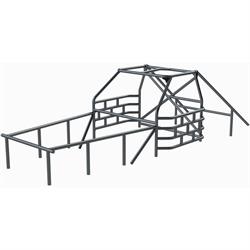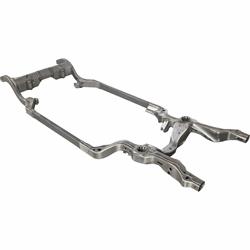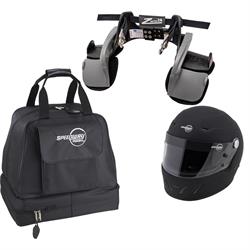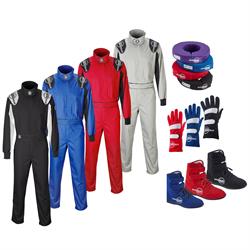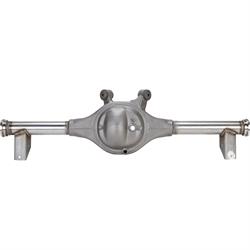How to Get into Stock Car Racing Dirt Track Style | Rules & Tips
Stock car racing is as American as apple pie, the Stars and Stripes, and blowing stuff up on the Fourth of July. The sport’s roots run especially deep in the South, where Prohibition-era bootleggers would modify their cars to outrun the law while transporting illegal moonshine. After Prohibition ended, those same drivers started racing each other–mostly for bragging rights–on open fields and makeshift dirt tracks. Promoters soon realized they could charge admission to these contests, and with that, stock car racing became part of the national fabric.
Back then, most races were held on the dirt. In fact, the very first race in NASCAR’s Strictly Stock Division (now called the Cup Series) took place in 1949 at Charlotte Fairgrounds Speedway–a 3/4 mile dirt oval full of bumps and dips; that season, seven of the eight tracks on the schedule were dirt. Over the next decade, dirt and clay tracks dominated the scene, giving drivers a rugged proving ground to sharpen their skills, slide through corners, and navigate unpredictable terrain.
As the sport grew and technology advanced, dirt slowly gave way to paved tracks, which were faster, smoother, and considered safer. But dirt racing never disappeared. Instead, it carved out its own niche, with dedicated drivers and fans, custom-built cars, and sanctioning bodies like the Super DIRTcar Series and the International Motor Contest Association (IMCA) carrying the torch for successive generations.
Today, that same spirit is alive and well. Whether you’re a lifelong fan or a newcomer interested in turning your first laps, stock car racing on dirt offers a rousing entryway into the world of grassroots motorsports. It’s relatively affordable, highly accessible, and full of heart-pounding, family-friendly excitement. Another plus: With the right direction, you can get on track faster than you think.
So, if you’re a new or aspiring racer–or simply curious about where to start–this guide is for you. We’ll break down key terminology, classes, parts, and tips to get you confidently headed toward your first green flag.
What is Stock Car Racing?
In its simplest form, stock car racing is competition between production-based vehicles that have been modified for better performance, durability, and safety. The term “stock” originally meant factory cars that came straight off the showroom floor. But over the years, that definition has shifted. Today, “stock car” covers everything from nearly street-legal vehicles to purpose-built machines that look nothing like what you'd see in a dealership.
While many of these cars are loosely based on an OEM frame or body style, almost all major components–from the engine to the suspension to the wiring and plumbing–have been upgraded for racing.
NASCAR is still by far the most recognizable form of stock car racing, and it typically plays out on paved tracks and superspeedways. But across the country, local dirt track racing is where the real grassroots action is. It’s insanely popular, with intense, door-to-door battles taking place weekly for months on end. It’s also where several of the sport’s legends got their start–icons like Junior Johnson, Richard Petty, and Ralph Earnhardt all cut their teeth in the dirt before becoming household names.
Because of its comparatively low cost of entry and non-stop rush, dirt stock car racing remains one of the most enjoyable and widely followed forms of motorsports today.
Dirt Stock Car Racing: What You Need to Know
Compared to the more polished, higher-profile world of asphalt, dirt stock car racing is decidedly user-friendly. Most events take place at local short tracks–typically quarter-mile to half-mile dirt or clay ovals–where racers haul their cars on open trailers and square off against familiar faces in front of family, friends, and hometown crowds.
Classes are defined by rule sets that cover things like engines, chassis, tires, and suspension parts that helps keep costs in check and the playing field even. Entry-level divisions often require mostly stock components, while the higher-tier classes allow for more mods and options.
With several hundred dirt tracks scattered across the country–each with its own quirks and personality–there’s tons of variety. You’ve got tight, close-quarters bullrings like River Cities Speedway in Grand Forks, ND, and long-straightaway, high-banked ovals like Hagerstown (MD) Speedway. No two tracks are exactly alike; conditions even vary from week to week, if not daily. And that unpredictability keeps drivers on their toes. Most race nights follow a similar format: heat races to set the lineup, B-mains (or qualifiers) to fill the field, and an A-main to crown the winner.
Stock Car Racing Classes: IMCA, Street Stock, Factory Stock & More
More often than not, dirt tracks either follow sanctioning body rules or adopt similar ones for their classes. Some of the most common stock car divisions for dirt racers are categorized below.
IMCA Stock Car
Sanctioned by the IMCA, this class is widely considered one of the toughest and most competitive in grassroots dirt racing. IMCA Stock Cars can run either GM 602 or 604 crate engines, or factory-built production V8s. Aftermarket blocks aren’t allowed. Engine displacement is typically capped at 362 cubic inches for Chevy, 364 for Ford, and 370 for Dodge. As for the bodies, they must resemble American-made passenger cars and use factory-style perimeter frames with the original rails intact, or an IMCA-approved aftermarket chassis.
Street Stock Car
A popular entry-level or intermediate class depending on where you are, these cars typically run older factory frames–like 1970s or ’80s GM, Ford, or Mopar models–with a few reinforcements, bolt-in cages, and minimal suspension tweaks. Under the hood, you’ll usually find stock or lightly modified V8s. Some tracks allow engine swaps and aftermarket bodies, while others stick to mostly OEM parts. It’s a solid mix of speed and affordability, with straightforward rules that make it relatively easy to get started.
Factory Stock Car
Built to keep costs low and competition aligned, this class features cars that are closer to true “stock” than what you’ll find in Street Stocks. We’re talking GM, Ford, or Mopar models that were mass-produced in the U.S. Expect to see factory-style suspension (no adjustable shocks, bump stops, bump springs, packers, or similar shock limiters), minimal engine mods (usually factory engines or sealed crate motors), and old-fashioned steel wheels. The rules are tight, so driver skill is often the deciding factor. Factory Stock is a common starting point for new racers and is especially popular across the South and Midwest.
More Stock Car Classes
Depending on where you are, you might come across terms like Hobby Stock or Pure Stock, sometimes with different classes under those names. These are usually the most affordable divisions, with extremely limited modifications allowed. Cars typically must keep full frames, interiors, and stock-style suspensions, and the engines are heavily restricted to keep costs down. Many tracks also run Sport Compact or 4-Cylinder classes. These small, FWD cars with four-bangers under the hood still fall under the “stock car” umbrella–and they’re another great entry point for dirt track racing newbies.
Of course, these are all just general guidelines. Some areas, for example, may use Factory Stock and Pure Stock interchangeably, while others might run them as separate classes. Always double-check with your local track or sanctioning body before you set out building or buying a car.
Stock Car Racing Chassis & Bodies
Stock Car Chassis Types Most dirt track stock cars are built on the GM A/G-body platform–RWD models like the Monte Carlo, Malibu, Cutlass, and Regal from 1978 to 1988. These cars are popular for their sturdy, lightweight frames, and because they’re still easy to find. You’ll often hear the term “metric chassis” used, too. While it originally referred to GM’s 108-inch wheelbase, it’s now come to mean the entire platform.
From there, you’ve got two main options: OEM or aftermarket. OEM chassis are original factory frames that have been modified for racing and are common in entry-level classes and Street Stock divisions. An aftermarket stock car chassis, on the other hand, is a purpose-built tubular frame designed to meet specific rulebook requirements. These are more often found in IMCA Stock Cars and higher-tier classes. Speedway Motors offers a full lineup of metric G-body chassis frame kits to help you build safe, modern-geometry frames that meet the rules for your class.
Stock Car Bodies
Most sanctioning bodies allow steel, aluminum, or fiberglass bodies that look like production models–Monte Carlo, Camaro, Mustang, or generic “ABC” styles. You can find full-size body panels sold individually or in kits that typically include the roof, quarters, nose, and tail sections. As you’d expect, Speedway carries a wide selection of stock car body panels and stock car parts, all of which are designed to meet track-legal dimensions and fit common chassis builds.
What Kind of Engine to Dirt Stock Cars Use?
Stock car engine rules are determined by class, but many dirt stock cars run small block V8s, with allowable mods spelled out in each division’s rulebook. For example, IMCA Stock Cars often use a sealed 602 motor or 604 crate motor, or built motors with specific limitations like hydraulic cams, cast iron heads, and 500 CFM carburetors.
Street Stocks might run a 350 Chevy block or 400 cubic inch V8s, depending on your local track’s rulebook. Some tracks allow things like aluminum intake manifolds or headers, while others may be more restrictive.
Factory Stocks and Pure Stocks are usually pretty basic. These classes often call for stock-block V8s with very minor modifications, e.g., cast iron heads, flat tappet cams, and lower compression ratios.
Regardless of what class you’re running, Speedway Motors has a full selection of stock car racing engines, carburetors, and engine dress-up kits, including options that are fully IMCA-compliant.
How to Get into Stock Car Racing
Getting your feet wet–or dirty–in stock car racing is easier than you probably realize. The first step is to find a local track, which you should be able to do using an online track locator or through regional sanctioning bodies like IMCA or DIRTcar. Once you’ve found a spot, head out on a race night, talk to some drivers and officials, and get a feel for the atmosphere.
Next is picking a class to race in. For beginners, your best bet is something like Factory Stock, Pure Stock, or Hobby Stock. If your local track offers them, Sport Compact or 4-Cylinder classes are good options, too. These divisions tend to have tighter rulebooks, simpler setups, and more manageable costs. Speaking of rules, most definitely read the rulebook before you buy anything so you don’t end up wasting money on parts you can’t use.
In terms of getting a car, you’ve got a couple of options. One is to buy a race-ready car off Facebook Marketplace, one of the online racing forums, or a motorsports-specific classifieds site. Prices can range from a few thousand dollars for an older car to around $10,000 for something newer and nicer. If you’re the DIY type, you could even save some scratch by building your own.
You’ll also need to transport your car to and from the track. Most racers use a pickup and a flatbed or enclosed trailer. Used trailers can start around $1,500 if you keep an eye out for deals; or ask around–you might get lucky with someone looking to unload theirs on the cheap.
Safety gear is a must. At the very least, you’ll need proper dirt track racing seats, a racing harness, racing window net kit, racing fire suit, SFI-certified helmet, HANS device, racing gloves, and racing shoes. Speedway Motors sells safety bundles that make it easy to get what you need in one shot instead of sourcing from different sellers.
One of the best parts of dirt racing is the community. Don’t hesitate to chat up other racers at the track, join Facebook groups, or hit up driver meetings. Odds are you’ll find lots of folks willing to offer advice and help you get started.
Dirt Stock Car Build Basics: What to Expect
Building a competitive dirt stock car is no small task. But with the right game plan and a solid handle on the basics, it’s definitely doable. Once you’ve landed on a class, the next big step is locking down the chassis. Most racers start with a clean GM metric chassis or aftermarket bare frame. This is the foundation of your build, and you’ll need to reinforce it to meet class rules. That usually means stiffening the frame rails and adding cage tie-ins, especially around the front horns and rear clip.
You’ll also need to install a full roll cage, one most likely made from 1.75-inch DOM steel tubing. For first timers, pre bent roll cage tubing kits (like those from Speedway Motors) can save time and headaches. They’re designed to fit a GM metric chassis, which means less fabrication and better fitment right out of the box. In addition, you’ll need the usual safety gear–racing seat, belts, helmet, gloves, etc. Plus an automotive fire extinguisher or onboard fire suppression system, along with a fuel cell, battery box, and kill switch kit.
As for the powertrain, that’ll depend heavily on your class. Some divisions mandate sealed crate engines, while others allow built motors, as long as you stay within the rules. That might mean using a specific type of cam and/or heads or limiting your carb to a two-barrel. Same goes for transmissions, where the rulebook or sanctioning body will spell out exactly what’s legal. In DIRTcar Stock Car, for example, a number of tracks only permit OEM-style transmissions (2-speed, 3-speed, 4-speed, or automatic), while others allow aftermarket transmissions. Most rules also call for steel bellhousings and transmission shields. Meantime, rear ends are usually GM 10-bolts or Ford 9-inch rear ends, and locked differentials with spools or mini-spools are common as well.
Again, the rulebook is your roadmap. It covers everything from ride height and tire width to suspension components and engine specs. Get to know it inside and out so you don’t waste money on parts you can’t run.
How Fast Do Stock Cars Go?
Speed on a dirt track mostly comes down to what car you’re driving and current surface conditions. That said, Pure Stock or Factory Stock cars usually top out around 60 to 75 mph. Step up to Street Stocks or IMCA Stock Cars, and you’re looking at speeds in the 80 to 100 mph range. On larger tracks–like a half-mile oval–the higher-powered classes can push well past the 100-mph mark.
How Much Horsepower Does a Stock Car Have?
Horsepower varies depending on the rules for your class and what kind of engine you’re running. For example, Factory Stock or Pure Stock cars typically make somewhere around 275 to 350 horsepower. Street Stocks tend to fall in the 375 to 450 hp range, while IMCA Stock Cars can produce anywhere from 400 to 475 hp, depending on whether it’s a crate engine or built motor. In open classes, you’ll often see cars making 500 horsepower or more. If you're running a crate setup, a Chevy 602 usually puts out around 350 hp, while the 604 bumps that up to about 400. Another option, the M-6007-D347SR/JR sealed crate motor from Ford Performance Parts, produces 415 hp.
What is a Pure Stock Dirt Car?
Pure Stock is one of the most beginner-friendly ways to get into dirt racing. Cars use mostly factory parts–stock suspension, near-stock engines, and engine-body combinations that match the original make and model. Depending on where you race, this class might also be called Factory Stock or Hobby Stock, but the idea is the same: keep costs down and competition up, making it a great entry point for new drivers.
Start Dirt Racing in No Time!
Getting behind the wheel of a dirt stock car is one of the most accessible and satisfying ways to scratch the racing itch. With a little mechanical knowhow, some solid research, and support from dependable partners like Speedway Motors, you’ll be turning laps in a competitive car before you know it.
Whether you’re picking out your first Factory Stock or putting together an IMCA-ready build from scratch, Speedway has you covered with chassis kits, suspension kits, safety gear, engines, and everything else you need to confidently take on your local dirt racetrack.
